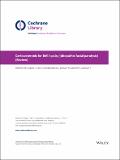Files in this item
Corticosteroids for Bell's palsy (idiopathic facial paralysis)
Item metadata
| dc.contributor.author | Madhok, Vishnu B. | |
| dc.contributor.author | Gagyor, Ildiko | |
| dc.contributor.author | Daly, Fergus | |
| dc.contributor.author | Somasundara, Dhruvashree | |
| dc.contributor.author | Sullivan, Michael | |
| dc.contributor.author | Gammie, Fiona | |
| dc.contributor.author | Sullivan, Frank | |
| dc.date.accessioned | 2017-07-19T09:30:10Z | |
| dc.date.available | 2017-07-19T09:30:10Z | |
| dc.date.issued | 2016-07-18 | |
| dc.identifier | 249621949 | |
| dc.identifier | 5d4dbf93-f3e7-4d76-a8d9-7e326aeedbeb | |
| dc.identifier | 27428352 | |
| dc.identifier | 84978763042 | |
| dc.identifier.citation | Madhok , V B , Gagyor , I , Daly , F , Somasundara , D , Sullivan , M , Gammie , F & Sullivan , F 2016 , ' Corticosteroids for Bell's palsy (idiopathic facial paralysis) ' , Cochrane Database of Systematic Reviews , no. 7 , CD001942 . https://doi.org/10.1002/14651858.CD001942.pub5 | en |
| dc.identifier.issn | 1469-493X | |
| dc.identifier.uri | https://hdl.handle.net/10023/11252 | |
| dc.description.abstract | Background: Inflammation and oedema of the facial nerve are implicated in causing Bell's palsy. Corticosteroids have a potent anti-inflammatory action that should minimise nerve damage. This is an update of a review first published in 2002 and last updated in 2010. Objectives: To determine the effectiveness and safety of corticosteroid therapy in people with Bell's palsy. Search Methods: On 4 March 2016, we searched the Cochrane Neuromuscular Specialised Register, the Cochrane Central Register of Controlled Trials (CENTRAL), MEDLINE, EMBASE and LILACS. We reviewed the bibliographies of the randomised trials and contacted known experts in the field to identify additional published or unpublished trials. We also searched clinical trials registries for ongoing trials. Selection criteria: Randomised trials and quasi-randomised trials comparing different routes of administration and dosage schemes of corticosteroid or adrenocorticotrophic hormone therapy versus a control group receiving no therapy considered effective for this condition, unless the same therapy was given in a similar way to the experimental group. Data collection and analysis: We used standard Cochrane methodology. The main outcome of interest was incomplete recovery of facial motor function (i.e. residual facial weakness). Secondary outcomes were cosmetically disabling persistent sequelae, development of motor synkinesis or autonomic dysfunction (i.e. hemifacial spasm, crocodile tears) and adverse effects of corticosteroid therapy manifested during follow-up. Main results: We identified seven trials, with 895 evaluable participants for this review. All provided data suitable for the primary outcome meta-analysis. One of the trials was new since the last version of this Cochrane systematic review. Risk of bias in the older, smaller studies included some unclear- or high-risk assessments, whereas we deemed the larger studies at low risk of bias. Overall, 79/452 (17%) participants allocated to corticosteroids had incomplete recovery of facial motor function six months or more after randomisation; significantly fewer than the 125/447 (28%) in the control group (risk ratio (RR) 0.63, 95% confidence interval (CI) 0.50 to 0.80, seven trials, n = 895). The number of people who need to be treated with corticosteroids to avoid one incomplete recovery was 10 (95% CI 6 to 20). The reduction in the proportion of participants with cosmetically disabling sequelae six months after randomisation was very similar in the corticosteroid and placebo groups (RR 0.96, 95% CI 0.40 to 2.29, two trials, n = 75, low-quality evidence). However, there was a significant reduction in motor synkinesis during follow-up in participants receiving corticosteroids (RR 0.64, 95% CI 0.45 to 0.91, three trials, n = 485, moderate-quality evidence). Three studies explicitly recorded the absence of adverse effects attributable to corticosteroids. One trial reported that three participants receiving prednisolone had temporary sleep disturbances and two trials gave a detailed account of adverse effects occurring in 93 participants, all non-serious; the combined analysis of data from these three trials found no significant difference in adverse effect rates between people receiving corticosteroids and people receiving placebo (RR 1.04, 95% CI 0.71 to 1.51, n = 715). Author's conclusions: The available moderate- to high-quality evidence from randomised controlled trials showed significant benefit from treating Bell's palsy with corticosteroids. | |
| dc.format.extent | 40 | |
| dc.format.extent | 613422 | |
| dc.language.iso | eng | |
| dc.relation.ispartof | Cochrane Database of Systematic Reviews | en |
| dc.subject | Anti-Inflammatory Agents | en |
| dc.subject | Bell Palsy | en |
| dc.subject | Cortisone | en |
| dc.subject | Glucocorticoids | en |
| dc.subject | Humans | en |
| dc.subject | Methylprednisolone | en |
| dc.subject | Prednisolone | en |
| dc.subject | Prednisone | en |
| dc.subject | Randomized Controlled Trials as Topic | en |
| dc.subject | Recovery of Function | en |
| dc.subject | Vitamins | en |
| dc.subject | RA0421 Public health. Hygiene. Preventive Medicine | en |
| dc.subject | SDG 3 - Good Health and Well-being | en |
| dc.subject.lcc | RA0421 | en |
| dc.title | Corticosteroids for Bell's palsy (idiopathic facial paralysis) | en |
| dc.type | Journal item | en |
| dc.contributor.institution | University of St Andrews. School of Medicine | en |
| dc.identifier.doi | 10.1002/14651858.CD001942.pub5 | |
| dc.description.status | Peer reviewed | en |
| dc.date.embargoedUntil | 2017-07-18 |
This item appears in the following Collection(s)
Items in the St Andrews Research Repository are protected by copyright, with all rights reserved, unless otherwise indicated.

